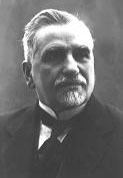Nationality Russian Role Architect Occupation Architect | Buildings Sokol Building, Moscow Name Ivan Mashkov | |
 | ||
Projects Restoration of Moscow Kremlin Cathedrals and Novodevichy Convent | ||
Ivan Pavlovich Mashkov (Russian: Ива́н Па́влович Машко́в, 1867–1945) was a Russian architect and preservationist, notable for surveying and restoration of Dormition Cathedral of Moscow Kremlin, Novodevichy Convent and other medieval buildings. His best known extant building is Sokol (Falcon) luxury Art Nouveau apartment building in Kuznetsky Most Street, Moscow. A prolific architect, Mashkov built mostly eclectic buildings with Russian Revival features.
Contents
- Education and early career
- Sokol Building
- Neoclassical revival
- Preservation and public activities
- Soviet period
- Own design extant buildings and monuments
- Restoration
- References
Education and early career
Ivan Mikhailovich Sokolov (Иван Михайлович Евдокимов), son of a village blacksmith, lost both his parents in early childhood. He was adopted by Pavel Karpovich Mashkov, a Lipetsk businessman, and his wife, Natalya Yefimovna (née Andreyeva), thus acquiring the name of Mashkov. Natalya's brother, Alexey Yefimovich Andreev, was a town architect in Lipetsk.
In 1881, Ivan was admitted to Moscow School of Painting, Sculpture and Architecture. He graduated Alexander Kaminsky class of architecture with an honorary medal and a construction license in 1886 at the age of 19 – an exceptionally quick education by any standard (normally, it would take 10 to 15 years from admissions to professional license).
In 1885–1888, Mashkov assisted Konstantin Bykovsky on Devichye Pole campus planning and August Weber on the completion of Polytechnical Museum in Moscow. In 1889–1890 he visited Lipetsk and completed there two schools, a hospital and a prison chapel – at the age of 23. Back in Moscow, Mashkov completed over a dozen buildings still in his twenties, and his masterpiece – the Sokol – at the age of 36.
Sokol Building
Mashkov's Sokol (Falcon) building is unique not only for his career, but to Moscow Art Nouveau in general. It is the only building in the city designed in original Vienna Secession style (see Illarion Ivanov-Schitz for a modified version of Secession). Its gilded roof and abundant forged iron ornaments looked like a citation from Otto Wagner (these ornaments were eventually lost). At the same time, the building is definitely Muscovite; the shape of its frieze repeats the lines of nearby Hotel Metropol.
The majolica mosaic of a falcon flying over a stormy sea was made by Nikolay Sapunov (of Mir Iskusstva art group). The subject of this picture itself is a double citation – from Maxim Gorky's Song of a falcon (1899) and from nearby Moscow Art Theater's Seagull symbol (1903). However, the building has nothing to do with these symbols or with Mashkov's natural name – it was named after M.V. Sokol, the owner.
Neoclassical revival
Mashkov's work prior to Sokol belongs to traditional muscovite eclectics and moderate Russian Revival of 1880s-1890s, and does not stand out among hundreds of similar buildings of this period. An unusually large share of his work was built for public charities, which ruled out expensive decorations and interiors. The only decoration he allowed was Abramtsevo majolica.
After the Russian Revolution of 1905, the public lost the interest in Art Nouveau; architects responded with a revival of Neoclassicism. Mashkov completed two private buildings (Tverskoy Pawn Shop and Eggert Apartments) in a stern, Saint Petersburg version of this style. In 1912-1913, he built his last major project - psychiatric hospital in Poteshnaya Street (now, Gannushkin Hospital). These buildings didn't make architectural landmarks; Mashkov, however, did make a lasting statement with his iconic monument to Ivan Fydorov (sculpture by Sergei Volnukhin).
Preservation and public activities
Like many contemporary architects, Mashkov was keen on studying and preserving historical national architecture, and in 1898 joined the Moscow Archaeological Society. He surveyed many historical churches and monasteries in Moscow, Dmitrov, Borovsk etc., published his own studies and edited the journal of Society. Mashkov supervised restoration of Kremlin cathedrals, Sukharev Tower, St.Basil Cathedral and other memorial buildings. In 1908-1918, he also co-chaired Moscow Architectural Society and contributed to the construction of House of Architects (17, Yermolayevsky Lane, currently Museum of Modern Art). In 1908-1933, he managed the Architectural Department of Polytechnical Museum, the forerunner of present-day Museum of Architecture. He is credited with editing the best guide to architecture of Moscow (1913).
Despite his reputation as preservationist and archaeologist, Mashkov joined the emerging skyscraper movement in 1913, and proposed a 13-story highrise on Tverskaya Street. The City Hall blocked this proposal and banned further highrise construction in the center of Moscow.
Soviet period
At the time of Russian Revolution of 1917, Mashkov was employed by the City of Moscow as deputy to City Architect. Bolshevik administration retained him in his office, and for some time Mashkov acted as the City Architect, engaged mostly in maintenance of the city in the middle of a civil war.
In 1929, Mashkov and sculptor Nikolay Andreyev erected the neoclassical monument to Aleksandr Ostrovsky near Maly Theater. Mashkov continued surveying memorial buildings (some of them already scheduled for demolition) and headed the restoration of Pashkov House (then known as Rumyantsev Museum, later Lenin Library and Russian State Library). He took no part in architectural disputes of 1920s, but was present in professional journals and wrote college textbooks (1935).
In 1934, Mashkov became a professor in Moscow Architectural Institute; since 1935 he chaired the department of architecture of Moscow Construction Institute. In 1937, he was awarded the title of Hero of Labor (1927 statute, predecessor of 1938 Hero of Socialist Labor title). Mashkov remained well established in Soviet academic circles until his death and was buried with honors at Novodevichy Cemetery; his book on Novodevichy Convent was reissued posthumously in 1949.
